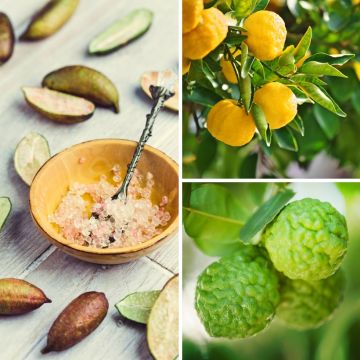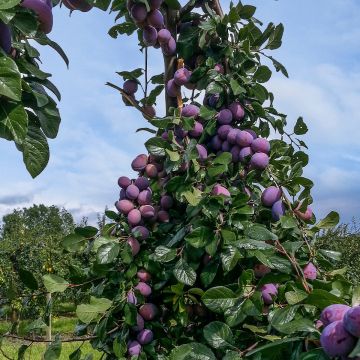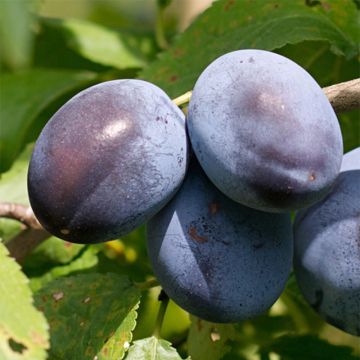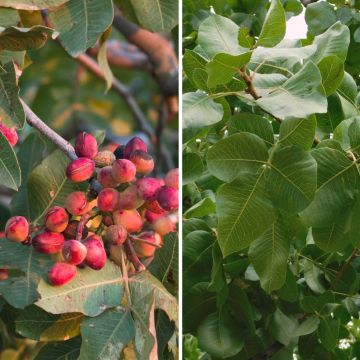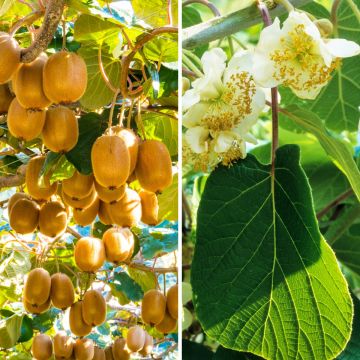

Organic Queen Claude Plum Pollinator Duo
Organic Queen Claude Plum Pollinator Duo
Prunus domestica Reine Claude d'Althan, Reine Claude Dorée
This plant carries a 6 months recovery warranty
More information
We guarantee the quality of our plants for a full growing cycle, and will replace at our expense any plant that fails to recover under normal climatic and planting conditions.
From €5.90 for pickup delivery and €6.90 for home delivery
Express home delivery from €8.90.
Delivery to Corse prohibited: UE law prohibits the import of this plant from mainland France to Corse as part of the fight against Xylella fastidiosa. Please accept our sincere apologies.
More information
Collection items (2 plants)
Description
This pair of Organic Queen Claude plums consists of the excellent varieties 'Queen Claude d'Althan', which produces large, round, and absolutely delicious purple plums, and 'Queen Claude Dorée', whose round fruits are yellow-green with a golden-yellow tint in the sun and are known for their juicy and sweet flesh. These two plum trees cross-pollinate each other, promoting good production. The plum harvest extends from mid-August to September. Bare-root scions from Organic Agriculture. Planting is preferably done in autumn.
This pair consists of:
- x1 Organic 'Queen Claude d'Althan' Plum: an excellent old variety, vigorous, with abundant, fairly regular, and high-quality production. The tree, reaching a height of 6m (20ft), produces large, slightly flattened, round fruits covered with a reddish-purple, even violet skin. Their thick yellow flesh is fine, juicy, and aromatic. The harvest takes place from mid-August to September. This variety is not self-fertile and originates from Hungary. It was selected in 1860 by the gardener of Count d'Althan. It will be pollinated by the Queen Claude Dorée.
- x1 Organic 'Queen Claude Dorée' Plum: a variety that has been introduced in the southwest for a long time, easy to grow, renowned for the flavor of its large, round plums. The tree can reach a height of 8m (26ft). Its fruits ripen around mid-August, are round, and measure about 4cm (2in) in diameter. They have a thin, greenish-yellow skin, with a golden side where the plum receives sunlight. The pale yellow flesh is juicy, sweet, and aromatic, making it of excellent taste. A very good pollinating variety, the 'Queen Claude Dorée' is not self-fertile and requires the presence of another plum tree to fruit satisfactorially. It is slightly prone to fruit splitting before ripening, but without monilia. This plum tree is tolerant to Bark-Split disease bt withstands handling and transport well.
Individually labeled.
The original area of plum trees is believed to be Syria, not China. During the Roman hegemony in the region, various local fruits, including plums, were introduced to Rome. This fruit tree has a free and spreading habit. When pruned properly, it is easy to harvest. It requires little care and maintenance due to the natural openness of its branches. It prefers full sun or partial shade and can grow in any type of rich, moist, deep soil, even heavy soil, but not limestone.
Its deciduous leaves are oval, almost oblong, with serrated edges and slightly pubescent. They fall in autumn. Flowering occurs in April. The tree is then covered with white flowers that appear on the leafless branches of the previous year. They are not self-fertile, so it is necessary to plant another plum tree nearby to obtain fruits.
Intended for organic cultivation, the cultivation of Organic Plum trees will achieve better development under certain conditions. To prevent diseases and pests, it will be necessary to:
- choose a deep, light, rich, and well-draining soil,
- avoid planting in an area previously occupied by other woody plants,
- prune to promote tree ventilation,
- thin out to prevent the development of diseases on the fruits,
- apply compost in limited quantities in autumn, depending on the fertility of your soil, and plant cover crops around the base,
- create multi-species hedges (except prunus), stone and wood piles, and nest boxes (for birds, voles, and bats) to attract beneficial insects.
If a disease appears, it will be necessary to remove and burn the affected parts.
Plums are consumed raw at the base of the tree, in fruit salads, as well as in desserts, pastries, and as accompaniments to meat and other dishes. They can be transformed into jams, fruit in syrup, and compotes. They can also be used to make eau-de-vie.
For transport reasons, our tallest scions may be pruned before shipping. They are suitable for all common training forms, except for high standards: cordons, espaliers, goblets, half-standards, and low standards. If you would like more information or advice on training your fruit trees, please do not hesitate to contact us.
Report an error about the product description
Plant habit
Fruit
Flowering
Foliage
Botanical data
Prunus
domestica
Reine Claude d'Althan, Reine Claude Dorée
Rosaceae
Cultivar or hybrid
Other Plum Trees
Planting and care
The Organic Queen Claude Plum tree grows in any type of light, rich, neutral or acidic soil, moist but not excessively humid and without limestone. Ensure proper drainage of the planting hole with a layer of gravel. Dig a good hole two to three weeks before planting. On the day of planting, place the tree in a basin of water to moisten the entire root ball. Install compost at the bottom of the hole. Place the tree in the hole and fill with a mixture of soil and compost. Do not bury the graft union. Firmly tamp down the soil around the base. The root ball should be completely covered. Water thoroughly.
You can add a small handful of wood ash, rich in potassium, during winter to improve fruiting.
Planting period
Intended location
Care
This item has not been reviewed yet - be the first to leave a review about it.
Our fruit tree and berry bush collection
Haven't found what you were looking for?
Hardiness is the lowest winter temperature a plant can endure without suffering serious damage or even dying. However, hardiness is affected by location (a sheltered area, such as a patio), protection (winter cover) and soil type (hardiness is improved by well-drained soil).

Photo Sharing Terms & Conditions
In order to encourage gardeners to interact and share their experiences, Promesse de fleurs offers various media enabling content to be uploaded onto its Site - in particular via the ‘Photo sharing’ module.
The User agrees to refrain from:
- Posting any content that is illegal, prejudicial, insulting, racist, inciteful to hatred, revisionist, contrary to public decency, that infringes on privacy or on the privacy rights of third parties, in particular the publicity rights of persons and goods, intellectual property rights, or the right to privacy.
- Submitting content on behalf of a third party;
- Impersonate the identity of a third party and/or publish any personal information about a third party;
In general, the User undertakes to refrain from any unethical behaviour.
All Content (in particular text, comments, files, images, photos, videos, creative works, etc.), which may be subject to property or intellectual property rights, image or other private rights, shall remain the property of the User, subject to the limited rights granted by the terms of the licence granted by Promesse de fleurs as stated below. Users are at liberty to publish or not to publish such Content on the Site, notably via the ‘Photo Sharing’ facility, and accept that this Content shall be made public and freely accessible, notably on the Internet.
Users further acknowledge, undertake to have ,and guarantee that they hold all necessary rights and permissions to publish such material on the Site, in particular with regard to the legislation in force pertaining to any privacy, property, intellectual property, image, or contractual rights, or rights of any other nature. By publishing such Content on the Site, Users acknowledge accepting full liability as publishers of the Content within the meaning of the law, and grant Promesse de fleurs, free of charge, an inclusive, worldwide licence for the said Content for the entire duration of its publication, including all reproduction, representation, up/downloading, displaying, performing, transmission, and storage rights.
Users also grant permission for their name to be linked to the Content and accept that this link may not always be made available.
By engaging in posting material, Users consent to their Content becoming automatically accessible on the Internet, in particular on other sites and/or blogs and/or web pages of the Promesse de fleurs site, including in particular social pages and the Promesse de fleurs catalogue.
Users may secure the removal of entrusted content free of charge by issuing a simple request via our contact form.
The flowering period indicated on our website applies to countries and regions located in USDA zone 8 (France, the United Kingdom, Ireland, the Netherlands, etc.)
It will vary according to where you live:
- In zones 9 to 10 (Italy, Spain, Greece, etc.), flowering will occur about 2 to 4 weeks earlier.
- In zones 6 to 7 (Germany, Poland, Slovenia, and lower mountainous regions), flowering will be delayed by 2 to 3 weeks.
- In zone 5 (Central Europe, Scandinavia), blooming will be delayed by 3 to 5 weeks.
In temperate climates, pruning of spring-flowering shrubs (forsythia, spireas, etc.) should be done just after flowering.
Pruning of summer-flowering shrubs (Indian Lilac, Perovskia, etc.) can be done in winter or spring.
In cold regions as well as with frost-sensitive plants, avoid pruning too early when severe frosts may still occur.
The planting period indicated on our website applies to countries and regions located in USDA zone 8 (France, United Kingdom, Ireland, Netherlands).
It will vary according to where you live:
- In Mediterranean zones (Marseille, Madrid, Milan, etc.), autumn and winter are the best planting periods.
- In continental zones (Strasbourg, Munich, Vienna, etc.), delay planting by 2 to 3 weeks in spring and bring it forward by 2 to 4 weeks in autumn.
- In mountainous regions (the Alps, Pyrenees, Carpathians, etc.), it is best to plant in late spring (May-June) or late summer (August-September).
The harvesting period indicated on our website applies to countries and regions in USDA zone 8 (France, England, Ireland, the Netherlands).
In colder areas (Scandinavia, Poland, Austria...) fruit and vegetable harvests are likely to be delayed by 3-4 weeks.
In warmer areas (Italy, Spain, Greece, etc.), harvesting will probably take place earlier, depending on weather conditions.
The sowing periods indicated on our website apply to countries and regions within USDA Zone 8 (France, UK, Ireland, Netherlands).
In colder areas (Scandinavia, Poland, Austria...), delay any outdoor sowing by 3-4 weeks, or sow under glass.
In warmer climes (Italy, Spain, Greece, etc.), bring outdoor sowing forward by a few weeks.





































